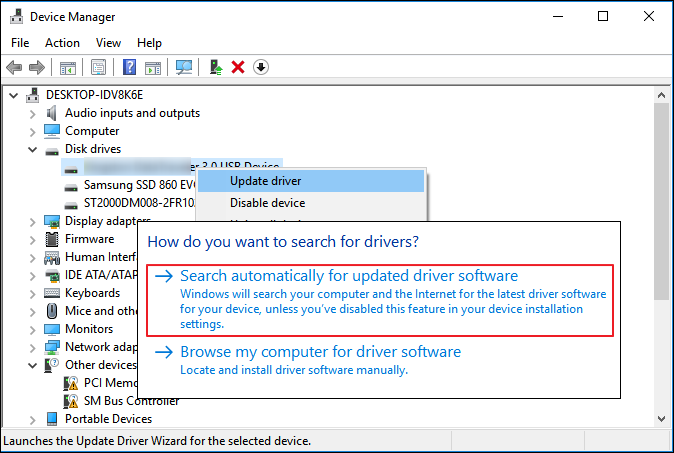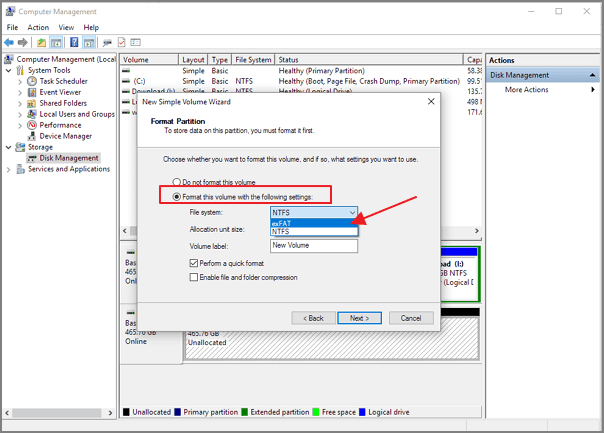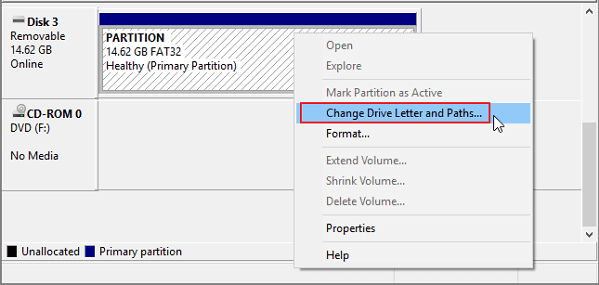How to Fix Buffalo External Hard Drive Not Working/Recognized

"I have had this Buffalo 2TB of external storage, unplugged from my computer several months. The last time I used it everything seemed fine. Today I decided to upload more documents from my computer to free up space on my hard drive, I am stuck with a non-functioning external hard drive......I have so much important documents stored on it, shrugs!!! I am so furious please help......"
Is this the same case for you? That is could be a normal image that your external hard drive is connected and recognized by the computer. What if your Buffalo external hard disk is not showing up? Terrible! This page now lists reliable ways to fix Buffalo's external hard drive not working. Go to the Fixes:
| Workable Solutions | Step-by-step Troubleshooting |
|---|---|
| 1. Update Driver | Press Windows + X, and click Device Manager from the menu...Full steps |
| 2. Create New Volume | Right-click the unallocated space on the external hard drive, and choose...Full steps |
| 3. Format Buffalo Hard Drive | Plug the external hard drive and open the Disk Management...Full steps |
| 4. Change Drive Letter | Press Windows + X and click Disk Management to start...Full steps |
Why My Buffalo External Hard Drive Not Showing Up
Check the following reasons for a recognized Buffalo hard disk:
- Damaged USB port or cable.
- Application conflict.
- Outdated driver.
- The computer can not recognize the format of the external device.
- Driver letter conflict.
- ...
Before repair this issue in every possible way, you can try to change your USB port or cable for a quick check. Partly, the USB port or cable is damaged. If your device owns more than one USB port, try another port to test whether the hard drive is detectable or not. If it is valid, go ahead to recover your data first and then apply another possible way.
Recover Data Before Advanced Troubleshooting
Unrecognized? Then how to access important data stored on it? And the advanced repair methods may cause data loss, like one of the ways relate to formatting your hard disk. So, before applying any tricks to fix your undetectable problem, you should do data recovery first.
Deep Data Recovery can recover files from any corrupted storage devices, including internal/external hard drives, USB flash drives, memory cards, and more. In three steps, you can recover your data from an external hard drive easily.
Click the download button to install Deep Data Recovery on your Windows or Mac, and check the step-by-step guide:
Step 1. Select file types and click "Next" to start
- Download and install Qiling Data Recovery on your PC or laptop.
- Connect the external hard drive to your computer.
- Launch Deep Data Recovery. Select file types and click "Next" to start.

Step 2. Choose and scan the external hard drive
- Choose the external drive from External drives list. Then, click scan for lost data.

Step 3. Check the scan results
- Qiling data recovery software will immediately scan the selected drive for all data, including deleted, corrupted, and existing data.
- You can use the Filter feature to quickly locate the files of one kind, such as Pictures, Word, Excel, PDF, videos, emails, etc.

Step 4. Preview and recover data
- Double-clicking a file from the scanned results to preview.
- Choose the files you want and click "Recover".
- Select a different drive to save the recovered files instead of the original one.
Fix 1. Update Driver
If your operating system does not support this hard drive, then your device surely can not show up. What you can do is update the driver.
Step 1. Press Windows + X, and click Device Manager from the menu.
Step 2. Expand Disk Drives and find your external device from the list.
Step 3. Right-click the external hard drive icon and then choose Update Driver.
Step 4. Choose Select automatically for updated driver software.

Step 5. Wait for the process to finish and check your disk on the computer.
Fix 2. Create New Volume (Unallocated space in Disk Management)
Sometimes your Disk Management is a good helper to check your device's situation even it is not showing up or recognized as before. You can check Disk Manager first. (Press Windows + R and click Disk Management.)
If your disk shown as unallocated space, do the steps as follows:
Step 1. Right-click the unallocated space on the external hard drive, and choose New Simple Volume.

Step 2. On the new simple volume wizard window, click Next.
Step 3. Select the file system, allocation unit size, and volume label.
Select file system as NTFS or exFAT. Choose the volume size or accept the default size. Assign a drive letter to your volume.

Step 4. Click Next. Review your configurations and click Finish.
If your external hard drive is shown as RAW in Disk Management, read on solution 3 in the next part.
Fix 3. Format Buffalo External Hard Drive (RAW in Disk Management)
If the device's partition is shown as RAW in the Disk Management, that means your files system has a problem that your format can not be recognized. So you should format the external hard disk.

Note: Formatting will erase all data on the device. Make sure you have recovered data with Qiling data recovery software.
Step 1. Plug the external hard drive and open the Disk Management.
Step 2. Right-click the external hard drive and choose Format from the drop-down menu.
Step 3. Select the file system and set the volume label. (Check the Quick Format.)
Step 4. Click Start to format your drive.
Fix 4. Change Drive Letter
Another culprit is the drive letter of the external hard drive may conflict with the hard drive.
Step 1. Press Windows + X and click Disk Management to start.
Step 2. Select the volume and choose Change Drive Letter and Paths option.

Step 3. Choose a new drive letter and click OK.
Fix 5. Other Complementary Methods (Optional)
Suspend the use of Security Software: The security software may affect the hard drive to be detected. So you can suspend or uninstall software and connect again.
Connect the external hard drive to another computer: You can connect Buffalo external hard drive to another computer. If it is showing up, that means your computer does not support Buffalo external hard drive.
To Sum Up
On this page, we have introduced one data recovery software and 5 fixes for you. No matter what method you are using, you should recover data at the very first with Deep Data Recovery. Speaking of fixes to cope with Buffalo external hard drive not working/recognized, you can try the first four methods. Any questions or better solutions, please contact us via support@idiskhome.com.
Related Articles
- Data Recovery Software Free Download Full Version with Crack (Version 13.5)
- Raw Drive Recovery: How to Recover Data from RAW Drive with Ease
- How to Recover Deleted Files from Laptop/PC on Windows 10/8/7
- Text Recovery Converter Word | Fix Corrupted Word and Recover Text